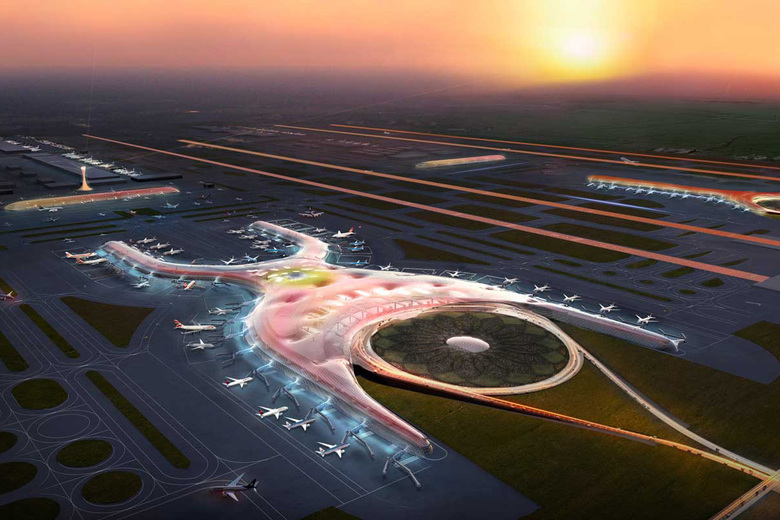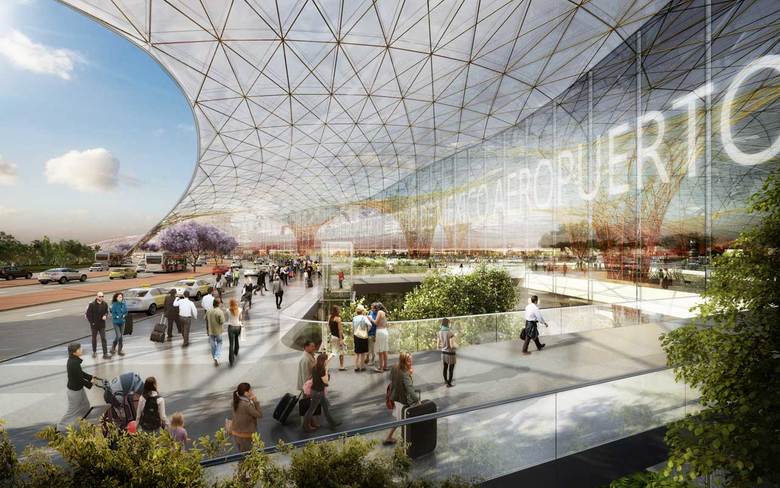Foster Wins One Airport, Loses Another
John Hill
4. September 2014
Mexico City airport expansion. Image: Foster + Partners
Lord Norman Foster, with Fernando Romero, has been selected to design Mexico City's new airport, while the Airports Commission has ruled out Foster’s Thames Hub proposal for a future London airport.
Yesterday Mexico’s President Enrique Peña Nieto announced that a collaboration between Foster + Partners, FR-EE (Fernando Romero Enterprise) and NACO (Netherlands Airport Consultants) has won the international competition to design Mexico City’s new international airport. Per a statement from Foster + Partners, the 555,000 m2 airport "revolutionizes airport design – the entire terminal is enclosed within a continuous lightweight gridshell, embracing walls and roof in a single, flowing form, evocative of flight." It is also designed to be "the world’s most sustainable airport" through its compact plan and lightweight glass and steel structure engineered for Mexico City's "challenging soil conditions."
Mexico City airport expansion. Image: Foster + Partners
In the same statement, Lord Foster explains: "Stansted Airport’s reinvention of the conventional terminal in the 1990s was emulated worldwide – this breaks with that model for the first time. It pioneers a new concept for a large-span, single airport enclosure, which will achieve new levels of efficiency and flexibility – and it will be beautiful. The experience for passengers will be unique. Its design provides the most flexible enclosure possible to accommodate internal change and an increase in capacity. Mexico has really seized the initiative in investing in its national airport, understanding its social and economic importance and planning for the future. There will be nothing else like it in the world."
Mexico City airport expansion. Image: Foster + Partners
The good news in Mexico City comes a couple days after Foster's Thames Hub proposal, backed by London Mayor Boris Johnson (and dubbed Boris Island due to his enthusiasm for the project), was rejected the independent Airports Commission in favor of a runway expansion at Gatwick or Heathrow. The Hub, which Foster proposed in 2011, would have been located in the Thames Estuary on the Isle of Grain, incorporating high-speed rail, manufacturing distribution, and flood control, in addition to a new, four-runway international airport.
Since Stansted Airport, completed in 1991, Lord Foster – an avid pilot – has completed three more airports (four if Virgin's Spaceport in New Mexico is counted): Chek Lap Kok Airport (Hong Kong, 1998), Beijing Airport (China, 2008), and Queen Alia International Airport (Jordan, 2012). These projects parallel the increasing size and passenger capacity of airports, culminating in Foster and Romero's design: The $9.15 billion Mexico City airport is designed to handle 120 million passengers a year, per Reuters. By comparison, Beijing Capital International Airport handles approximately 80 million passengers a year, London Heathrow around 70 million, and Frankfurt Airport close to 60 million.
Thames Hub. Image: Foster + Partners
Thames Hub. Image: Foster + Partners
In a statement Foster + Partners cite their island airport for Hong Kong as a precedent for the new airport in the Thames Estuary, while they criticize the Airport Commission's feasibility study of the proposal as inaccurate in regards to costs and call the alternatives myopic: "Adding a third runway at Heathrow is merely a short term fix - it will inevitably lead to a fourth runway in order to maintain international hub status." (The Mexico City airport is designed for three runways with a planned expansion to six in the future.) Regardless of the rejection, Boris Johnson has said the proposal is not dead, according to the BBC. The Commission's final recommendations are due to be announced in summer 2015.




